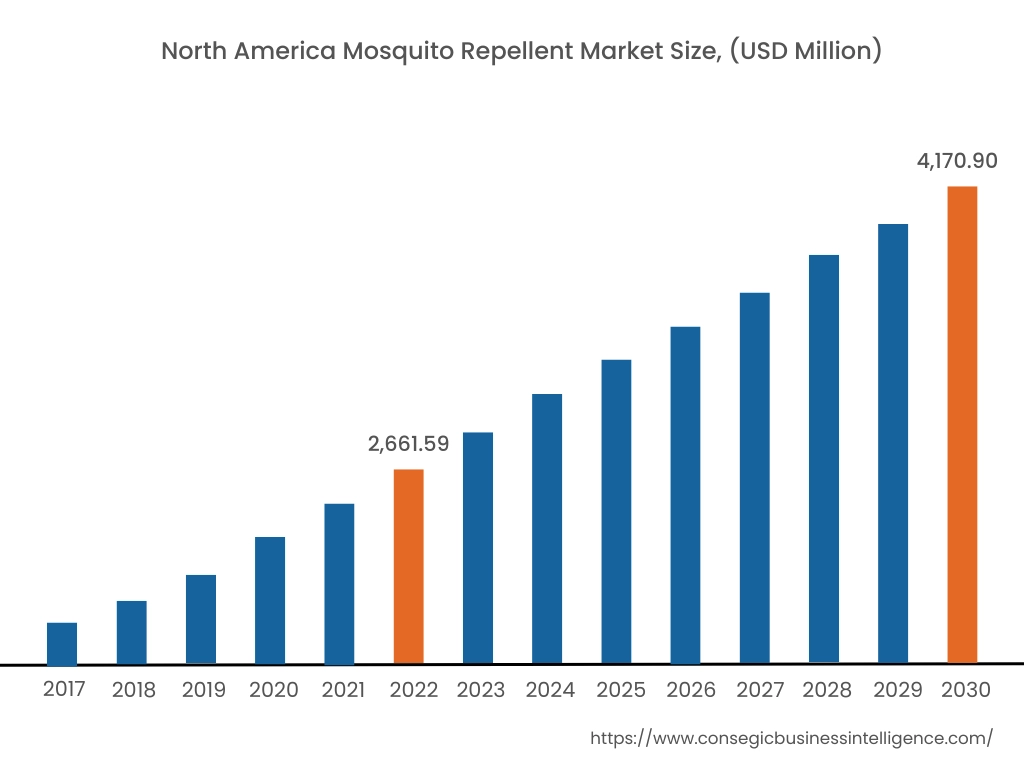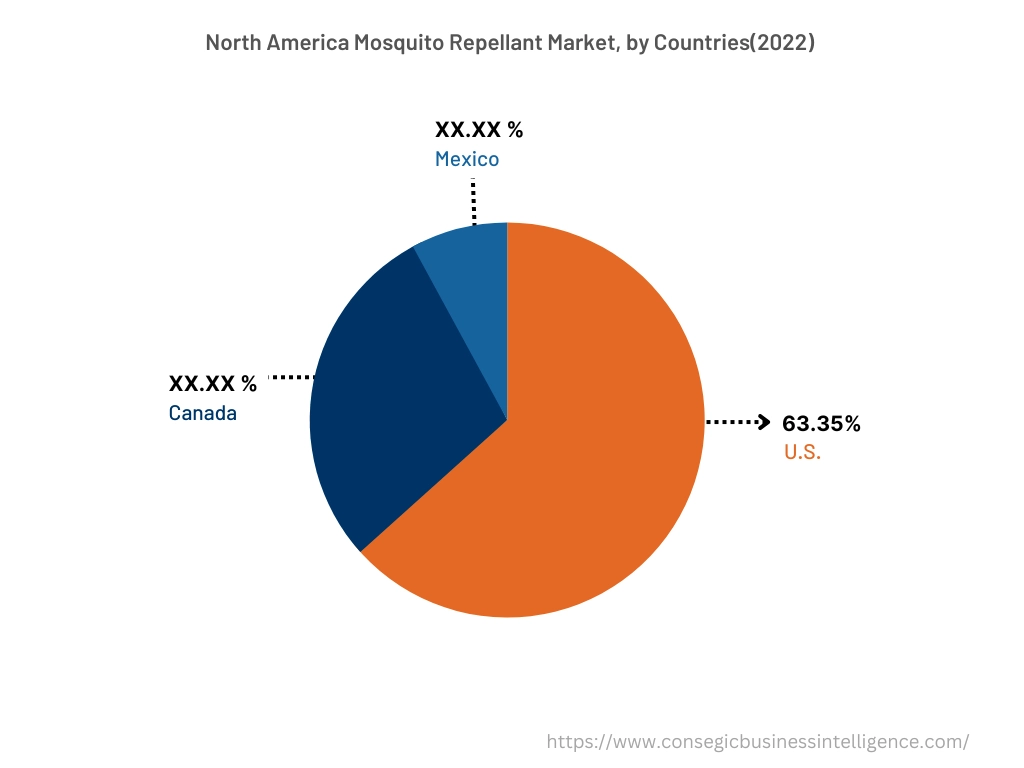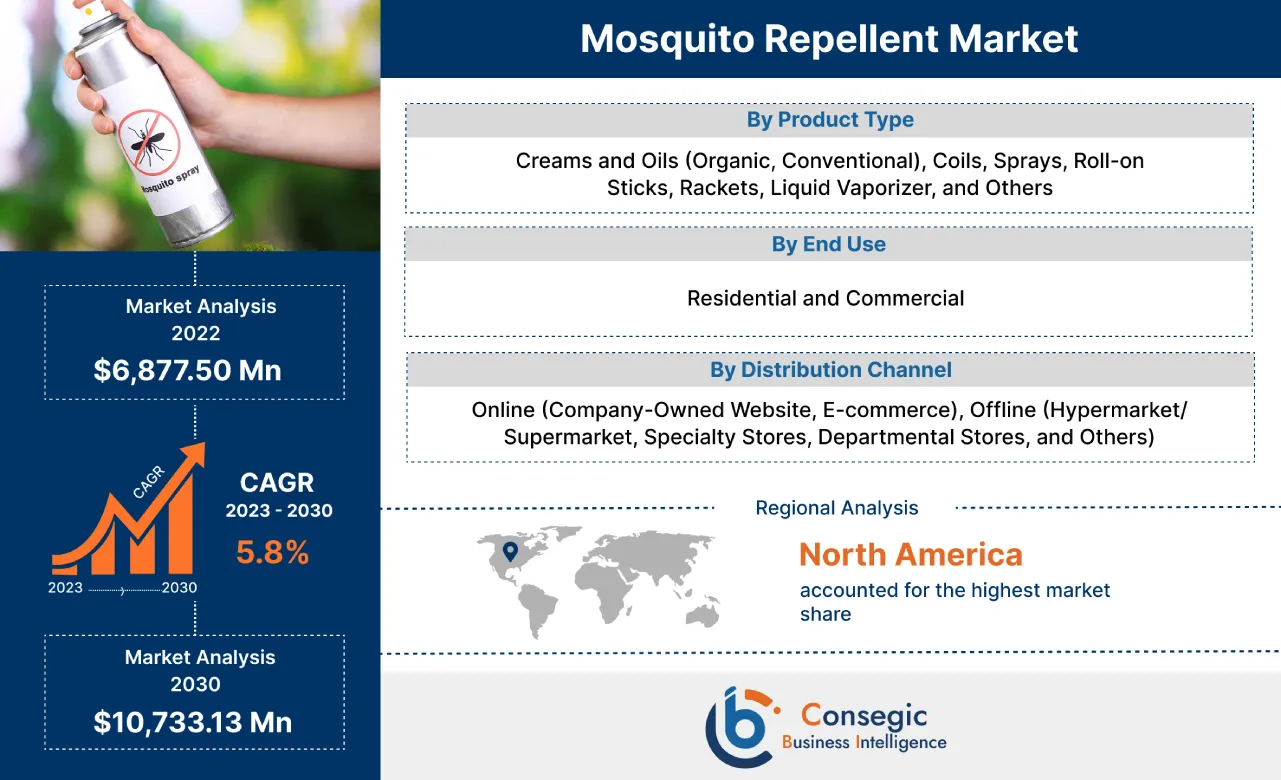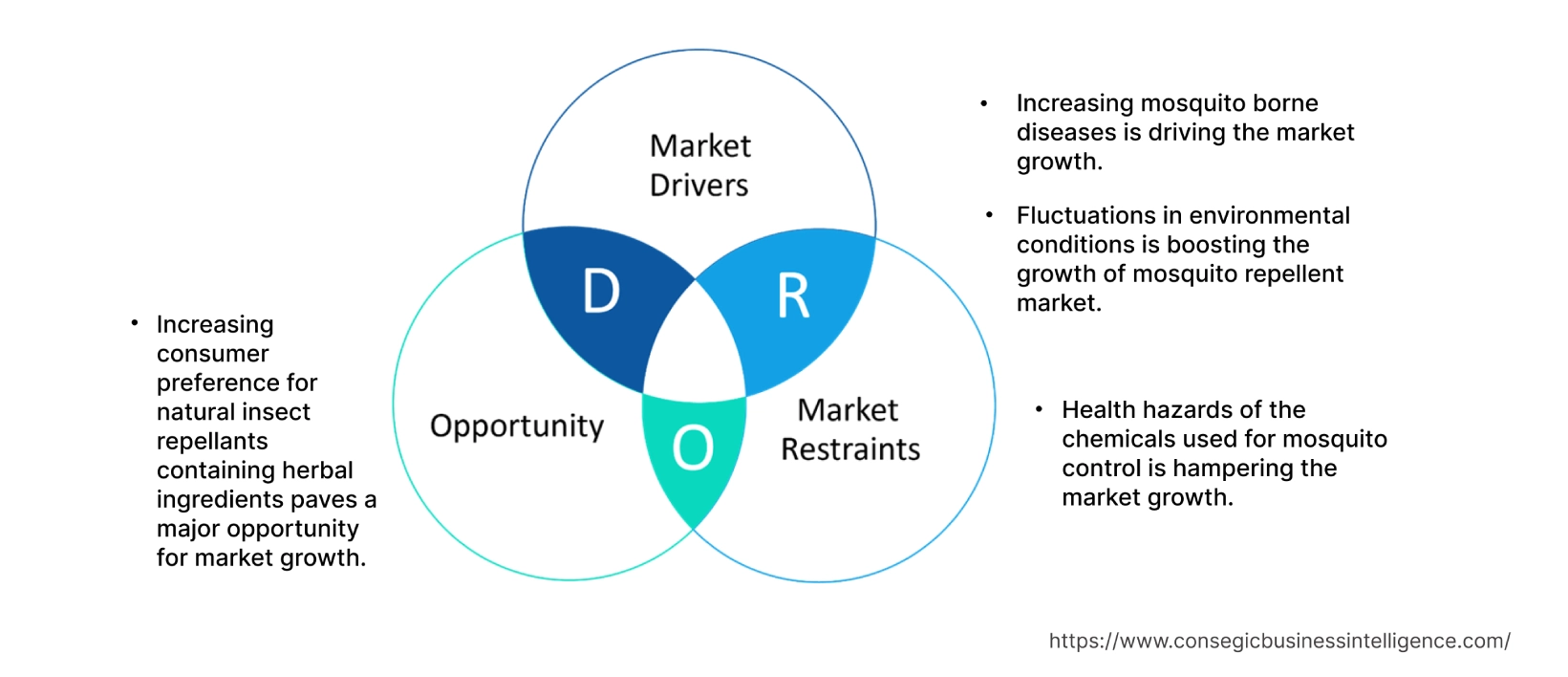Mosquito Repellent Market Size :
Consegic Business Intelligence analyzes that the mosquito repellent market size is growing with a CAGR of 5.8% during the forecast period (2023-2030), and the market is projected to be valued at 10,733.13 million by 2030 from 6,877.50 million in 2022.
Mosquito Repellent Market Scope & Overview:
A mosquito repellent is a substance applied to the skin, clothing, or other surfaces to discourage mosquitoes from landing or crawling on that surface. Insect repellents help prevent and control the outbreak of insect-borne diseases such as malaria, Lyme disease, dengue fever, bubonic plague, river blindness, and West Nile fever. Also, mosquito-spread diseases such as dengue, malaria, yellow fever, and others are increasing worldwide, which is leading to more usage of repellent products. Based on the analysis, they are an important tool for preventing mosquito-borne diseases. They should be used in combination with other measures, such as wearing long sleeves and pants, using insect netting, and staying indoors during peak mosquito hours.
How is AI Transforming the Mosquito Repellent Market?
AI is transforming the mosquito repellent market by enabling precision targeting, advanced product development, personalized consumer solutions, and enhanced supply chain management. It powers smart sensors and traps to detect mosquito populations and disease carriers, automates drone-based control efforts for safer and more efficient public health interventions, and accelerates the development of novel, effective, and eco-friendly repellents. Thus, this integration leads to personalized smart packaging, better inventory control, and improved consumer experiences, ultimately creating a more efficient and sustainable market.
Mosquito Repellent Market Insights :
Mosquito Repellent Market Dynamics - (DRO) :
Key Drivers :
Increasing mosquito borne diseases is driving the market
Rising mosquito-borne diseases have been playing a significant role in increasing the requirement for these products. Increased global warming has led rise in greenhouse concentrations in the atmosphere. Thus, it has led to the rising mosquito breeding globally. Hence, rising global warming has led to increasing usage of mosquito borne diseases in the market. Furthermore, as per the analysis, mosquitoe borne diseases including yellow fever, dengue, malaria, zika virus, and others are accountable for numerous deaths globally. Hence due to increasing mosquito borne diseases globally, there has been increased usage of repellent products in the market.
Fluctuations in environmental conditions is boosting the growth of mosquito repellent market
The effectiveness of mosquito repellent can be affected by several environmental conditions. Climate change has a direct positive impact on greater usage of repellent products. This is due to the increasing number of mosquitoes owing to increasing hot temperatures, and humid climate. Also, damp and wet climate conditions provide a suitable ground for mosquito multiplication. Hence, fluctuations in environmental conditions such as increasingly hot and humid climates due to global warming and heavy rains are propelling the mosquito repellent market growth. For instance, according to a recent report by Climate.gov 2022 was the sixth-warmest year on record, where in 2022 the surface temperature was around 1.55 °F, and annual global carbon emissions are projected to increase further in the long run. Hence, due to fluctuations in temperature due to changing environmental conditions, the market trend for repellent is growing at a significant rate.
Key Restraints :
Health hazards of the chemicals used for mosquito control is hampering the market
Mosquito-repellent products contain certain harmful chemicals such as DEET, pyrethroids, and permethrin. These chemical repellants cause ailments to the brain, skin, and bones. The other chemical repellants such as cyfluthrin bring in neurotoxicity during prolonged exposure. Also, certain repellent products such as sprays and coils cause severe skin reactions such as swelling, rashes, eye irritation, itching, and others. Hence, rising health hazards in consumers due to the harmful chemicals used in repellent products is hampering the market.
Future Opportunities :
Increasing consumer preference for natural insect repellants containing herbal ingredients paves a major opportunities for market
Rising demand for plant-based repellants which can be used for protection against both plant-eating insects and mosquitos, serves as the major mosquito repellent market opportunities and trends for the market. Usage of different skin friendly raw materials such as citronella, in repellent products, is driving the demand for natural products in the market. Due to the health hazards associated with conventional repellent products, especially in children and pregnant women there is rising demand for herbal products by the consumer. These herbal mosquito products last longer than conventional products and mitigate any chance of allergic reactions. Also, increasing developments of herbal products by the key players in the market which has botanical and natural ingredients, and increasing demand for neem-based repellent products are fostering market.
For instance, all the products of Herbal Strategi, one of the manufacturers and exporters of herbal-based home care products including floor cleaner, insect repellant, repellent, lizard repellent, and others are herbal and the ingredients are non-toxic & biodegradable, safe for kids and do not have any harmful chemicals. Hence, the aforementioned benefits of natural repellent products are creating lucrative opportunities and trends in the coming years.
Mosquito Repellent Market Report Insights :
| Report Attributes | Report Details |
| Study Timeline | 2017-2030 |
| Market Size in 2030 | USD 10,733.13 Million |
| CAGR (2023-2030) | 5.8% |
| By Product Type | Creams and Oils (Organic, Conventional), Coils, Sprays, Roll-on Sticks, Rackets, Liquid Vaporizer, and Others |
| By End Use | Residential and Commercial |
| By Distribution Channel | Online (Company-Owned Website, E-commerce), Offline (Hypermarket/Supermarket, Specialty Stores, Departmental Stores, and Others) |
| By Region | North America, Europe, Asia-Pacific, Latin America, and Middle East & Africa |
| Key Players | SC. Johnson & Son, Inc, Spectrum Brands Holdings, Inc., Sawyer Products, Inc., Dabur India Ltd, Himalaya Herbals, Jyothy Laboratories Ltd, Reckitt Benckiser Group plc., Herbal Strategi, 3M, Avon LLC, and Kao Corporation |
| Geographies Covered | |
| North America | U.S. Canada Mexico |
| Europe | U.K. Germany France Spain Italy Russia Benelux Rest of Europe |
| APAC | China South Korea Japan India Australia ASEAN Rest of Asia-Pacific |
| Middle East and Africa | GCC Turkey South Africa Rest of MEA |
| LATAM | Brazil Argentina Chile Rest of LATAM |
| Report Coverage | Revenue Forecast, Competitive Landscape, Growth Factors, Restraint or Challenges, Opportunities, Environment & Regulatory Landscape, PESTLE Analysis, PORTER Analysis, Key Technology Landscape, Value Chain Analysis, Cost Analysis, and Regional Trends & Forecast |
Mosquito Repellent Market Segmental Analysis :
By Product Type :
The product type segment is categorized into creams and oils (organic, conventional), coils, sprays, roll-on sticks, rackets, liquid vaporizers, and others. In 2022, the coils segment accounted for the highest mosquito repellent market share of 23.75% in the market. Coils are widely used in emerging regions due to the efficiency of the product in mitigating fatal diseases such as dengue, malaria, and others. This is considered a traditional method of repelling mosquitoes and is largely demanded as it is quite economical. Hence, based on the analysis, due to the affordability, portability, and long-lasting effectiveness of the product, there is a high requirement of coils-based repellent in the mosquito repellent market.
Moreover, the sprays segment is expected to grow at the fastest CAGR in the overall mosquito repellent market during this forecast period. This is due to the ease of use of the sprays on different fabrics and surfaces. The products are highly effective for those who work and play in areas surrounded by mosquitoes. Also, sprays work much faster than coils, mats, incense sticks, and others. Moreover, as per the analysis, the introduction of herbal spray products in the market by the key players, which are skin friendly and mitigate chances of allergic reactions is driving the segmental growth of sprays in the mosquito repellent market. For instance, Herbal Strategi, has manufactured a new set of herbal repellent room spray in 2021, which comes in different product sizes from 100 ml to 5 ltrs, and the products are herbal, non-toxic, eco-friendly, and biodegradable. Hence, different product launches in the herbal spray segment by the key players are driving the growth and trends of sprays in the mosquito repellent market.

By Distribution Channel :
The distribution channel segment is categorized into online (company-owned website, e-commerce), offline (hypermarket/supermarket, specialty stores, departmental stores, and others). In 2022, the offline segment accounted for the highest market share in the mosquito repellent market. The offline segment has been showcasing major demand due to the time delivery of the product, personalized recommendations from the staff, wide variety to choose from on the spot, and shopping satisfaction. Consumers do get advised by the sales staff about the advantages of different product types of mosquito repellent so that the consumers can check the quality of the product on spot and take a wise purchase decision accordingly. Hence, due to the aforementioned advantages of the offline segment, the offline segment is foreseeing high segmental trends in the market.
Moreover, the online segment is expected to grow at the fastest CAGR in the overall mosquito repellent market during this forecast period. This is due to the rise in e-commerce platforms and increasing digitalization across the globe. Consumers prefer ease of shopping, easy product returns, and thus online shopping is considered a time-saving approach. Also, as per the analysis, access to the product lines by the customers acts as a catalyst for the growth of the online segment. Hence, due to the mentioned advantages of online distribution channels, the segment in the mosquito repellent market is growing significantly.By End-User :
The end use segment is categorized into residential and commercial. In 2022, the residential segment accounted for the highest market share and is expected to grow at the fastest CAGR in the overall mosquito repellent market during this forecast period. The residential segment has been showcasing major requirements for repellent products as these are mostly used for personal use. The repellent products are widely used across residential spaces due to the prevention of any disease such as malaria, dengue, and others due to mosquito bites. Based on the analysis, the products have wide applications in residential buildings yards and gardens, rainwater tanks, washrooms, and others. Hence, increasing residential projects worldwide is leading to increased requirements for the mosquito repellent industry. Thus, due to growing residential projects and rising investment in this sector, there is significant trends being foreseen in the residential segment in the overall mosquito repellent market.
By Region :
The regional segment includes North America, Europe, Asia Pacific, the Middle East and Africa, and Latin America.

In 2022, North America accounted for the highest market share of 38.70% and was valued at USD 2,661.59 million and is expected to reach USD 4,170.90 million in 2030. In the North America region, the U.S. accounted for the highest market share of 63.35% during the base year 2022. Based on the mosquito repellent market analysis, this is due to rising health consciousness among individuals, coupled with the presence of major key players in this region. Also, increasing health awareness among U.S. residents due to advanced healthcare infrastructure in this region is boosting the growth of the mosquito repellent industry. Hence, the aforesaid factors are propelling the mosquito repellent market trends in North America.
Moreover, Asia Pacific is expected to grow at the fastest CAGR of 6.2% during the forecast period. This is due to rising consumer awareness and acceptance of mosquito repellent products in this region. Further, climate, geography, and lifestyle contribute to the major prevalence of mosquitoes in the Asia Pacific region. Rising cases of mosquito borne diseases in the slum regions is acting as a catalyst for mosquito repellent products. For instance, according to a recent study by the National Center for Vector Borne Diseases Control, malaria cases amounted to around 1,76,522 in 2022, which has increased from 1,61,753 in 2021, showcasing increasing mosquito borne diseases in this region. Hence due to increasing concerns for malaria, and dengue among others, there has been a large mosquito repellent market demands and trends in Asia Pacific.

Top Key Players & Market Share Insights:
The global mosquito repellent market is highly competitive, with several large players and numerous small and medium-sized enterprises. These companies have strong research and development capabilities and a strong presence in the market through their extensive product portfolios and distribution networks. The market is characterized by intense competition, with companies focusing on expanding their product offerings and increasing their market revenue through mergers, acquisitions, and partnerships. The key players in the market include-
- S.C. Johnson & Son Inc.
- Spectrum Brands Holdings, Inc.
- Herbal Strategi
- 3M
- Avon LLC
- Kao Corporation
- Sawyer Products, Inc.
- Dabur India Ltd
- Himalaya Herbals
- Jyothy Laboratories Ltd
- Reckitt Benckiser Group plc.
Recent Industry Developments :
- In January 2023, C. Johnson & Son, Inc. partnered with Tata Werneck to launch mosquito protection social media challenge. The partnership is expected to bring in insect management with more expertise in insect biology, physiology, ecology, behavior and toxicology, infestation management, and the prevention of insect-borne diseases such as malaria, dengue, and zika.
- In October 2021, Kao Corporation and Kose Corporation agreed to collaborate in the cosmetics sustainability domain, to identify sustainable solutions in the cosmetics business. This collaboration is expected to contribute to environmental protection and resource circulation in society.
Key Questions Answered in the Report
What was the market size of the mosquito repellent market in 2022? +
In 2022, the market size of mosquito repellent market was USD 6,877.50 million
What will be the potential market valuation for the mosquito repellent market by 2030? +
In 2030, the market size of the mosquito repellent market will be expected to reach USD 10,733.13 million.
What are the key factors driving the growth of the mosquito repellent market? +
Increasing mosquito borne diseases is the key factor driving the growth of the mosquito repellent market.
What is the dominating segment in the mosquito repellent market by product type? +
In 2022, the coils segment accounted for the highest market share of 23.75% in the overall mosquito repellent market.
Based on current market trends and future predictions, which geographical region will have the fastest impact on the mosquito repellent market's growth in the coming years? +
Asia Pacific is expected to be the fastest-growing region in the market during the forecast period.


